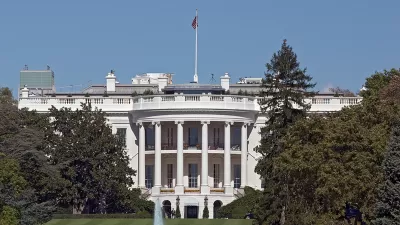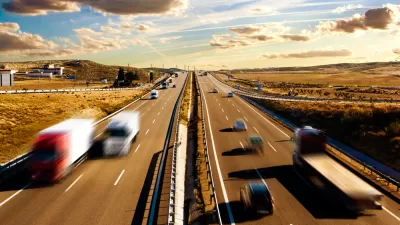The U.S. Environmental Protection Agency and U.S. Department of Transportation jointly issued final standards on Aug. 16 to reduce emissions and improve fuel economy for heavy duty trucks which currently average about six miles per gallon.

"The Obama administration on [Aug. 16] issued aggressive new emissions standards for heavy-duty trucks," reports Bill Vlasic for The New York Times. "The rules are expected to achieve better fuel efficiency and a bigger cut in pollution than the version that was first proposed last year."
Officials said the new standards would require up to a 25 percent reduction in carbon emissions for big tractor-trailers over the next 10 years, and somewhat smaller improvements for delivery trucks, school buses and other large vehicles.
As with regulations on emission standards for passenger vehicles (which include light trucks), the rules are jointly issued by the U.S. Environmental Protection Agency (EPA) and the U.S. Department of Transportation, specifically through the National Highway Traffic Safety Administration. EPA regulates greenhouse gas emissions while NHTSA regulates fuel efficiency, using the term Corporate Average Fuel Economy, or CAFE.
EPA Administrator Gina McCarthy "said the standards were 'ambitious but achievable,' and were decided after hundreds of meetings in the last year with groups representing truck manufacturers, fleet owners and environmental organizations," adds Vlasic. But they will add to the costs of new trucks, though they achieve cost savings too.
Analysts have estimated the cost of complying with the new standards at $12,000 a vehicle. [Transportation Secretary Anthony Foxx] said those investments would be outweighed by larger economic gains such as reduced fuel consumption.
[He] said the trucking industry would save an estimated $170 billion in fuel costs through 2027 and reduce petroleum consumption by two billion barrels over the lifetime of the vehicles sold under the new rules.
The new standards are welcome news for environmentalists. Transportation supplanted power plants last February as the largest source of carbon emissions in the U.S. economy. "Within the transportation sector, heavy-duty vehicles are the fastest-growing contributors to [greenhouse gas] emissions," according to an EPA-NHTSA fact sheet [PDF] on the new standards.
FULL STORY: New Rules Require Heavy-Duty Trucks to Reduce Emissions by 25% Over the Next Decade

Pennsylvania Mall Conversion Bill Passes House
If passed, the bill would promote the adaptive reuse of defunct commercial buildings.

Coming Soon to Ohio: The Largest Agrivoltaic Farm in the US
The ambitious 6,000-acre project will combine an 800-watt solar farm with crop and livestock production.

World's Largest Wildlife Overpass In the Works in Los Angeles County
Caltrans will soon close half of the 101 Freeway in order to continue construction of the Wallis Annenberg Wildlife Crossing near Agoura Hills in Los Angeles County.

California Grid Runs on 100% Renewable Energy for Over 9 Hours
The state’s energy grid was entirely powered by clean energy for some portion of the day on 37 out of the last 45 days.

New Forecasting Tool Aims to Reduce Heat-Related Deaths
Two federal agencies launched a new, easy-to-use, color-coded heat warning system that combines meteorological and medical risk factors.

AI Traffic Management Comes to Dallas-Fort Worth
Several Texas cities are using an AI-powered platform called NoTraffic to help manage traffic signals to increase safety and improve traffic flow.
City of Costa Mesa
Licking County
Barrett Planning Group LLC
HUD's Office of Policy Development and Research
Mpact Transit + Community
HUD's Office of Policy Development and Research
Tufts University, Department of Urban and Environmental Policy & Planning
City of Universal City TX
ULI Northwest Arkansas
Urban Design for Planners 1: Software Tools
This six-course series explores essential urban design concepts using open source software and equips planners with the tools they need to participate fully in the urban design process.
Planning for Universal Design
Learn the tools for implementing Universal Design in planning regulations.

























